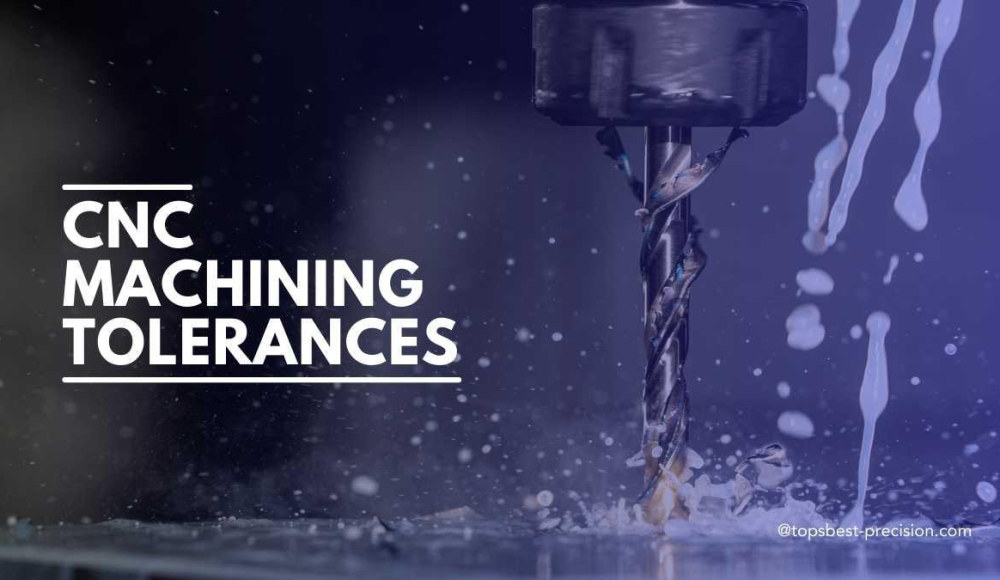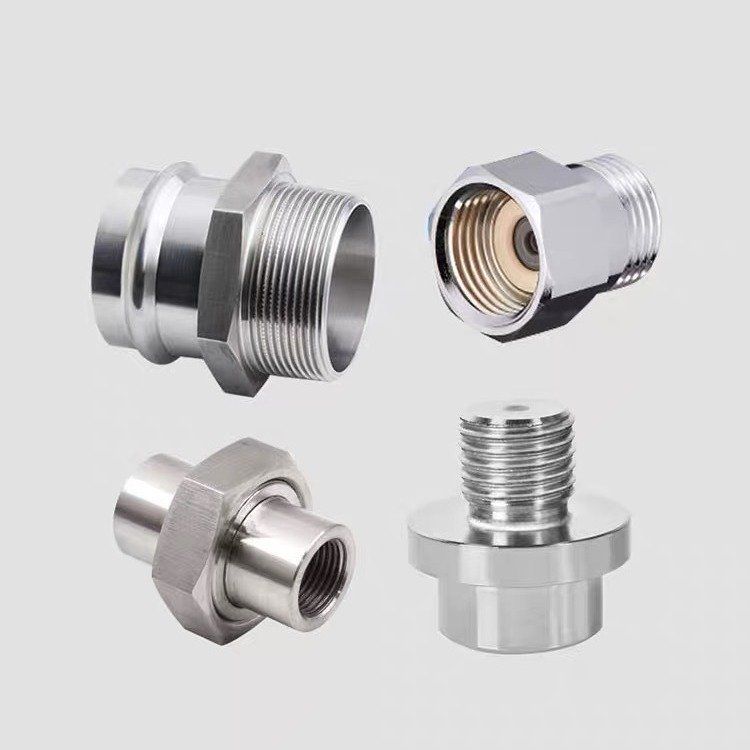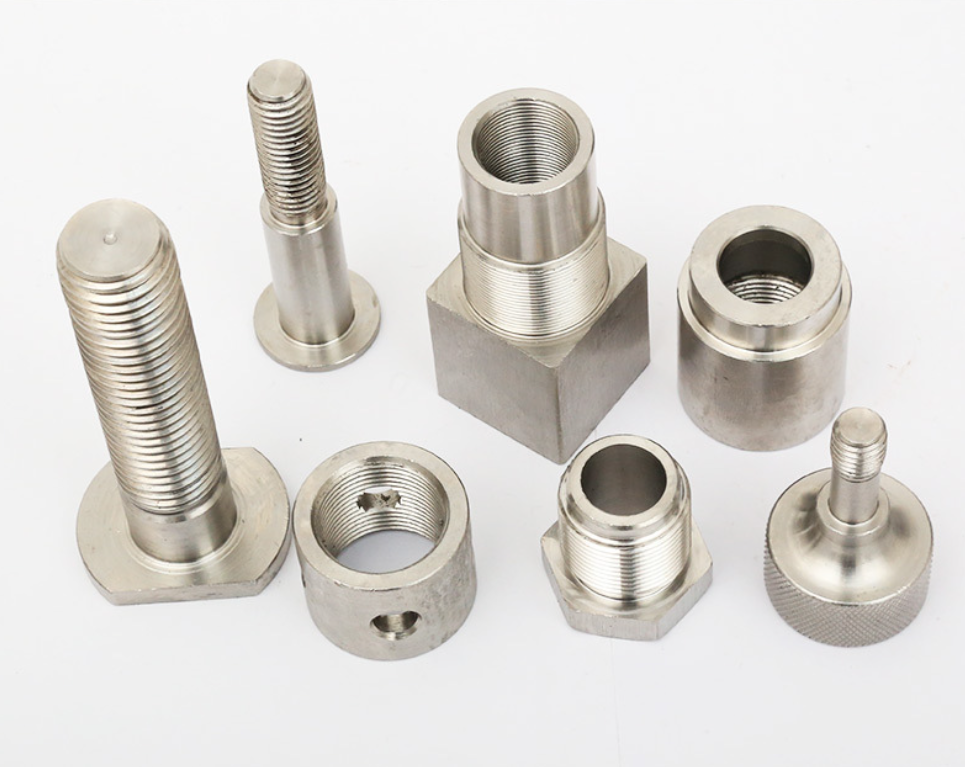Le tolleranze di lavorazione CNC sono fondamentali quando si realizzano prodotti, non importa per cosa sono usati. Oggi, La maggior parte dei prodotti, sia industriale che consumatore, deve essere coerente per soddisfare gli standard.
A causa di ciò, I produttori si affidano a diversi tipi di macchine a CNC per garantire un'elevata precisione nei loro progetti. Ma è importante capire quali sono le tolleranze di lavorazione, i loro tipi, Gli standard per loro, e come misurarli. Questo perché le dimensioni di Parti lavorate a CNC può differire dai valori teorici dovuti a fattori come il tipo di materiale, il processo di lavorazione, e design.
In questo articolo, Parleremo di tolleranze di lavorazione CNC, Perché contano, e condividere un grafico di tolleranze di lavorazione comuni. Continua a leggere per saperne di più sugli standard di tolleranza CNC e sui fattori che li influenzano.
Cosa sono le tolleranze di lavorazione?
Le tolleranze di lavorazione si riferiscono alla variazione consentita nelle dimensioni di una parte dal suo design originale. Nessun processo di produzione può ottenere 100% perfezione, Quindi le tolleranze definiscono la deviazione accettabile che garantisce correttamente le funzioni del prodotto finale.
La regola generale è:
- Tolleranze più piccole = maggiore precisione, Ma costi più elevati
- Tolleranze maggiori = precisione inferiore, ma costi inferiori
Per esempio, In Lavorazione CNC, Le tolleranze sono in genere scritte come ± 0,005 ″, Significa che la dimensione può essere 0.005 pollici sopra o sotto la dimensione prevista.
Calcolo ed espressione delle tolleranze di lavorazione
Per capire come funzionano le tolleranze, Dobbiamo familiarizzare con concetti chiave:
Terminologie chiave:
| Termine | Definizione |
| Dimensione di base | La dimensione prevista di una parte secondo il design |
| Dimensione effettiva | Le dimensioni prodotte finali dopo la lavorazione |
| Limite superiore | La dimensione massima accettabile |
| Limite inferiore | La dimensione minima accettabile |
| Deviazione | La differenza tra le dimensioni effettive e basilari |
| Dato | Un punto di riferimento o una linea utilizzata per la misurazione |
Condizioni materiali:
| Termine | Senso | Esempio |
| MMC (Condizione di materiale massima) | Quando una parte ha il più materiale possibile | Un albero al suo diametro più grande |
| LMC (Condizione minima materiale) | Quando una parte ha il minimo materiale possibile | Un buco al suo diametro più grande |
| Tolleranza bonus | Indennità extra per la variazione | Differenza tra MMC e LMC |
Formula di tolleranza:
Tolleranza = limite limite superiore -limite text{Tolleranza} = testo{Limite superiore} - testo{Limite inferiore}
Per esempio, Se viene specificato un albero come 10 ± 0.2 mm, Poi:
- Limite superiore= 10.2 mm
- Limite inferiore= 9.8 mm
- Tolleranza= 10.2 – 9.8 = 0.4 mm
Diversi tipi di tolleranze di lavorazione
Tolleranza unilaterale
- Cosa significa:
La variazione consentita è solo in una direzione. Per esempio, Se il design richiede un file 10 diametro mm con tolleranza unilaterale di +1 mm, la parte può essere 10 mm o fino a 11 mm, ma non più piccolo di 10 mm. - Quando usare:
Quando si desidera assicurarsi che una parte non si riduca delle dimensioni del design, che è importante per le parti che devono adattarsi a un gruppo stretto.
Tolleranza bilaterale
- Cosa significa:
La variazione è consentita in entrambe le direzioni. Per a 10 Diametro mm con tolleranza bilaterale di ± 1 mm, La parte può variare 9 mm a 11 mm. - Quando usare:
Quando hai bisogno di una parte che può essere un po 'più piccola o più grande della dimensione nominale, consentendo una maggiore flessibilità nella produzione, pur soddisfacendo i requisiti di progettazione.
Limitare la tolleranza
- Cosa significa:
Invece di usare una dimensione di base con una variazione ±, I limiti superiore e inferiore sono definiti esplicitamente. Per esempio, Una parte potrebbe essere necessaria per avere un diametro tra 9 mm e 11 mm. - Quando usare:
Quando si desidera che le dimensioni finali rientrassero rigorosamente all'interno di un intervallo specificato senza fare riferimento a un valore nominale.
Tolleranza al profilo
- Cosa significa:
Questo tipo controlla la forma o il contorno di una parte. Specifica che la curva della superficie deve rimanere all'interno di un intervallo definito. Pensalo come un "confine fuzzy" per un bordo curvo. - Quando usare:
È usato quando la forma esatta di una parte è cruciale, come nei componenti con curve complesse o superfici aerodinamiche.
Tolleranza all'orientamento
- Cosa significa:
La tolleranza all'orientamento limita quanto una parte può inclinare o deviare da un piano di riferimento o una linea (chiamato dato). Ciò potrebbe significare controllare la perpendicolarità o l'angolarità di una superficie. - Quando usare:
Quando l'angolo della parte è fondamentale, come in parti che devono allinearsi perfettamente per l'assemblaggio adeguato.
Tolleranza alla posizione
- Cosa significa:
Questa tolleranza garantisce che caratteristiche specifiche, come buchi o slot, sono nel luogo corretto rispetto a un dato. Definisce il passaggio accettabile dalla posizione prevista. - Quando usare:
Quando è necessario un posizionamento preciso delle funzionalità, come nei componenti che devono allinearsi con altre parti in un assemblaggio.
Tolleranza alla forma
- Cosa significa:
Le tolleranze della forma controllano la forma di una parte. Garantiscono caratteristiche come la planarità, rotondità, o la rettilità soddisfa le specifiche di progettazione, indipendentemente dalle dimensioni. - Quando usare:
Quando la forma generale di una superficie è importante, come su parti che devono mantenere un liscio, anche finire.
Tolleranza di runout
- Cosa significa:
La tolleranza di runout specifica quanto una funzione (Come un bordo circolare) può deviare quando la parte ruota attorno a un asse centrale. Garantisce che la parte rimanga concentrica e non vagala. - Quando usare:
Per parti che ruotano, come alberi e ingranaggi, per garantire un funzionamento regolare e un adattamento corretto nei gruppi.
Tolleranze disprezzate in modo ineguagliabile
- Cosa significa:
Queste tolleranze consentono variazioni ineguali in diverse direzioni. Invece di avere lo stesso limite di tolleranza su entrambi i lati della dimensione di base, Un lato potrebbe avere un abbigliamento più grande dell'altro. - Quando usare:
Quando la funzione di una parte richiede più materiale in una direzione rispetto all'altra, come per le caratteristiche che interagiscono con un'altra parte che ha i suoi limiti di tolleranza.
Sommario Tabella delle tolleranze di lavorazione
| Tipo di tolleranza | Definizione | Quando usare |
| Tolleranza unilaterale | Variazione consentita in una sola direzione (per esempio., 10 mm +1 mm) | Quando le parti non devono essere più piccole della dimensione di base. |
| Tolleranza bilaterale | Variazione consentita in entrambe le direzioni (per esempio., 10 mm ± 1 mm) | Per parti che possono essere leggermente più piccole o più grandi della dimensione nominale. |
| Limitare la tolleranza | Limiti superiore e inferiore definiti esplicitamente (per esempio., 9 mm a 11 mm) | Quando sono richiesti limiti dimensionali rigorosi senza riferimento a una dimensione nominale. |
| Tolleranza al profilo | Controlla la forma o la curva di una funzione | Per parti con curve critiche o superfici aerodinamiche. |
| Tolleranza all'orientamento | Limita la deviazione dell'angolo di una parte rispetto a un dato | Quando un preciso allineamento angolare è essenziale. |
| Tolleranza alla posizione | Specifica quanto una funzione può spostarsi dalla posizione prevista | Per un posizionamento accurato dei buchi, slot, o altre caratteristiche negli assiemi. |
| Tolleranza alla forma | Controlla la forma generale (planarità, rotondità, rette) | Quando è liscio, La forma corretta è vitale per la funzione o la vestibilità della parte. |
| Tolleranza di runout | Limita la variazione quando una parte ruota attorno a un asse | Per parti che devono ruotare senza oscillare, come alberi e ingranaggi. |
| Tolleranze disprezzate in modo ineguagliabile | Limiti di tolleranza diversi su ciascun lato della dimensione di base | Quando sono necessarie diverse indennità direzionali in base alla funzione parte. |
Cos'è iso 2768?
ISO 2768 è uno standard internazionale che definisce tolleranze generali per le parti lavorate, Offrire linee guida per le dimensioni lineari, Misure angolari, e tolleranze geometriche. Semplifica il processo di progettazione eliminando la necessità di specificare le singole tolleranze per ogni funzione, che è particolarmente utile per dimensioni meno critiche. ISO 2768 ha due classi di tolleranza: "Bene" (F) e "grossolano" (C), consentire a progettisti e produttori di allineare i livelli di tolleranza con i requisiti funzionali delle loro parti. L'uso di questo standard può risparmiare tempo, ridurre i costi di produzione, e garantire coerenza tra le operazioni di produzione.
Importanza delle tolleranze di lavorazione
La maggior parte delle parti realizzate utilizzando il controllo numerico computerizzato mostrano alcune variazioni intrinseche. Queste variazioni sono controllate da tolleranze per ottenere affidabilità e prestazioni migliori.
Miglioramento della precisione della parte
Le tolleranze CNC sono importanti per mantenere la compatibilità delle parti. Le tolleranze garantiscono che le parti lavorate si adattino bene agli assiemi. Inoltre, alcune funzionalità garantiscono che tutto funzioni come previsto nei casi d'uso indicati. Concentrazioni eccessive oltre tali limiti possono portare a classificare alcune di queste parti come difettose e quindi inutilizzabili.
Stabilire un margine di errore
Nella produzione, c'è sempre una variazione, indipendentemente dal processo utilizzato. Le deviazioni sono fornite dalle tolleranze di lavorazione, che definiscono i margini operativi. Questa specifica riduce al minimo le possibilità di richiamare una parte prodotta.
Controllo dei costi di lavorazione
Nella maggior parte dei casi, tolleranze più strette comportano un costo maggiore della lavorazione CNC. Alcune parti con tolleranze strette potrebbero richiedere altri metodi di finitura come la molatura, e superfinitura. Tuttavia, superfici più tolleranti consentono il completamento con semplici operazioni di lavorazione.
Mantenimento della qualità estetica dei prodotti
Una tolleranza di alta precisione indica l'aspetto finale delle parti lavorate. Per esempio, se due parti devono adattarsi strettamente, è necessario stabilire limiti più stretti al momento della progettazione. Ciò garantisce una perfetta aderenza ed elimina la possibilità di un'interfaccia ad incastro.
Tolleranze di lavorazione CNC: cose da considerare
Tolleranza significa incorporare le specifiche in una dimensione durante la progettazione di una parte. Ecco alcuni suggerimenti chiave da considerare quando si impostano le tolleranze per la lavorazione CNC:
Le tolleranze essenziali devono avere la priorità
La tolleranza è un aspetto critico della progettazione. Tuttavia, non tutte le caratteristiche devono essere tollerate. Come un modo per risparmiare tempo e denaro, applicare le tolleranze solo a tali caratteristiche, che influenzano altri componenti.
Non utilizzare tolleranze piccole/strette
Una tolleranza eccessiva può portare ad una maggiore quantità di scarti prodotti. Richiedono una calibrazione speciale, più serraggio, e tempi di taglio più lunghi rispetto a quelli convenzionali. Tutti questi fattori comportano costi generali più elevati.
Trattare le proprietà dei materiali
Il materiale utilizzato ha una grande influenza sulle tolleranze di lavorazione ottenibili. Ecco perché a volte è impossibile raggiungere le tolleranze specifiche indicate – dipende dal materiale. Per esempio, alcuni materiali possono essere flessibili, soprattutto quando vengono lavorati e, Perciò, diventa difficile raggiungere il livello di tolleranze richiesto.
Dimensionamento e tolleranze geometriche (GD&T)
GD&T è un sistema internazionale che standardizza il modo in cui le tolleranze sono specificate nei disegni ingegneristici.
| GD&Funzione T. | Scopo | Esempio |
| Rette | Assicura che una parte non sia curva | Una lunga bordo di metallo deve essere perfettamente dritta |
| Planarità | Controlla la uniformità della superficie | Una base a macchina non deve avere dossi |
| Circolarità | Assicura che una parte rotonda sia veramente circolare | Pistone anelli nei motori |
| Concentricità | Allinea il centro delle caratteristiche | I buchi devono allinearsi perfettamente |
Tolleranze di lavorazione CNC comuni
Nella lavorazione CNC, Le tolleranze standard si riferiscono al livello tipico di precisione che la maggior parte delle macchine può ottenere senza regolazioni speciali. Queste tolleranze assicurano che le parti soddisfino i requisiti del settore mantenendo i costi e i tempi di produzione ragionevoli.
| Processo di lavorazione CNC | Tolleranza tipica |
| Fresatura CNC (3-asse & 5-asse) | ± 0,005 ″ (0.13 mm) |
| Torna del tornio CNC | ± 0,005 ″ (0.13 mm) |
| Router CNC | ± 0,005 ″ (0.13 mm) |
| Incisione CNC | ± 0,005 ″ (0.13 mm) |
| Lavorazione delle viti | ± 0,005 ″ (0.13 mm) |
| Utensili per il taglio delle guarnizioni | ± 0,030 ″ (0.762 mm) |
| Taglio della rotaia | ± 0,030 ″ (0.762 mm) |
| Fustellatura con regola in acciaio | ± 0,015 ″ (0.381 mm) |
| Finitura superficiale | 125 RA (Rugosità media) |
💡 Takeaway chiave: La maggior parte dei processi di lavorazione CNC ha una tolleranza generale di ± 0,005 ″ (0.13 mm), Ma questo può cambiare a seconda del tipo di materiale, capacità della macchina, e esigenze specifiche del progetto.
Tolleranze strette vs. Tolleranze sciolte
Non tutte le parti hanno bisogno di tolleranze estremamente strette. Mentre tolleranze più strette migliorano la precisione, Aumentano anche i costi, Tempo di lavorazione, e requisiti di ispezione. Ecco una rapida guida per aiutarti a decidere:
| Tipo di tolleranza | Quando usare | Esempi |
| Tolleranza standard (± 0,005 ″) | La maggior parte delle parti CNC per lo scopo generale in cui non è richiesta una precisione estrema. | Parentesi a macchina, Distruggi di base, copertine. |
| Tolleranza stretta (± 0,001 ″ o meno) | Quando la precisione è cruciale per la funzione parte, come nelle applicazioni aerospaziali o mediche. | Componenti di aerei, strumenti chirurgici, Microelettronica. |
| Tolleranza allentata (± 0,010 ″ o più) | Quando la funzione di una parte non è influenzata da variazioni dimensionali minori, Ridurre i costi. | Pezzi decorativi, recinti di base, Supporti non critici. |
Fattori che influenzano le tolleranze nella lavorazione CNC
Normalmente, i prodotti sono realizzati secondo limiti di tolleranza standard tranne quando il cliente ha fissato limiti personalizzati. Esistono diversi motivi per consentire tolleranze nella produzione.
Proprietà dei materiali
La scelta dei materiali influisce direttamente sulla tolleranza ottenibile. Queste caratteristiche possono includere: abrasività, durezza del materiale, e resistenza al calore.
- Abrasività:Le frese CNC sono sensibili ai materiali grossolani. Tali materiali comportano un degrado più rapido dell'utensile. Inoltre, rendono difficile il raggiungimento di tolleranze molto strette.
- Durezza:Spesso è difficile lavorare materiali meno densi con grande precisione. Le sue dimensioni possono variare durante il taglio ed è per questo che si consiglia di pazientare mentre si ha a che fare con prodotti più morbidi/flessibili.
- Stabilità al calore:I materiali non metallici tendono a deformarsi durante i processi di lavorazione a causa del calore, prodotti durante i processi.
Scelta dei processi di lavorazione CNC
Il selezionato processo di lavorazione influisce sulle tolleranze date le differenze nelle caratteristiche superficiali e nella rugosità. Ogni tecnica di lavorazione CNC come la tornitura, fresatura, E macinazione offre punti di forza e sfide unici. Inoltre, varie macchine CNC con più assi possono avere tolleranze di base diverse. La consapevolezza di queste capacità significa che le tolleranze richieste saranno raggiunte, in particolare laddove i progetti hanno una tolleranza specificatamente specificata.
Effetti di finitura superficiale
Processi successivi come la verniciatura e l’anodizzazione possono influenzare le dimensioni della parte. Questi trattamenti superficiali possono posizionare le parti lavorate oltre i livelli di tolleranza normalmente desiderati per tali parti. Perciò, è fondamentale scegliere il giusto processo di finitura per ridurre le distorsioni.
Utensili da taglio CNC
Anche i tipi di utensili da taglio utilizzati nella lavorazione CNC hanno un impatto sulle tolleranze. Strumenti precisi, adeguatamente dimensionato e rivestito, e affilati offrono una maggiore precisione.
Considerazioni sul budget
Gli strumenti e i materiali devono essere scelti in base al budget del progetto. Tolleranze ridotte significano più tempo e strumenti specializzati che a loro volta aumentano significativamente i costi. L'acquisizione di strumenti di alta qualità garantisce che le parti prodotte abbiano la tolleranza necessaria e una finitura uniforme.
Competenza del macchinista
L’abilità e l’esperienza del macchinista sono fondamentali nella determinazione delle tolleranze. Un operatore esperto può scegliere gli utensili adeguati per il taglio, impostare i corretti fattori di lavorazione, e garantire che il processo soddisfi le caratteristiche necessarie.
Perché le tolleranze di lavorazione CNC contano?
Senza tolleranze adeguate, Le parti potrebbero non adattarsi correttamente, portando a disallineamenti, Problemi di assemblaggio, o addirittura guasto nel funzionamento. Scegliere la giusta tolleranza garantisce:
✅ Assemblaggio regolare di componenti
✅ Riduzione dei costi di lavorazione evitando una precisione inutile
✅ migliori prestazioni complessive del prodotto finale
Se non sei sicuro di quale tolleranza utilizzare per il tuo progetto, Una buona regola empirica è iniziare con ± 0,005 "e regolare secondo necessità in base alla funzione e ai requisiti della parte.
Come migliorare le tolleranze di lavorazione?
✅ Utilizzare macchine CNC di alta qualità.
✅ Scegli materiali appropriati per la lavorazione di precisione.
✅ Controllare i fattori ambientali come la temperatura.
✅ Utilizzare strumenti di misurazione avanzati come le macchine di misurazione delle coordinate (CMM).
Suggerimenti per Tolleranze di lavorazione CNC più strette
Scegli il materiale giusto
Non tutti i materiali macchina allo stesso modo. Alcuni si espandono, ordito, o logora gli utensili da taglio più velocemente, che può influenzare l'accuratezza della tolleranza.
🔹 Meglio per tolleranze strette: Acciaio inossidabile, alluminio, ottone, E titanio.
🔹 Più difficile da macchiare con precisione: Plastica, Metalli morbidi, compositi (A causa dell'espansione termica e della flessibilità).
💡 Mancia: Se stai lavorando con un materiale che si espande o si contrae con la temperatura, Prendi in considerazione l'uso di ambienti di lavorazione climatizzati.
Usa macchine a CNC di alta qualità
Il tipo e la condizione della macchina CNC incidono direttamente sulla precisione della parte finale.
✅ Scelta migliore: 5-Macchine CNC assi (maggiore flessibilità e precisione)
✅ Evitare: Macchine più vecchie o logori (Possono introdurre lievi errori a causa dell'usura meccanica)
💡 Mancia: Assicurarsi sempre che le macchine a CNC siano adeguatamente calibrate e mantenute per prevenire incoerenze.
Ottimizza gli utensili da taglio
L'uso degli utensili da taglio giusti è cruciale per raggiungere tolleranze strette. Gli strumenti opachi o di bassa qualità possono causare tagli irregolari e scarse finiture superficiali.
✔ Usa gli strumenti in carburo o rivestiti di diamanti - Rimangono acuti e riducono la deflessione degli strumenti.
✔ Usa la giusta velocità di alimentazione & Velocità - troppo veloce può causare chiacchiere; Troppo lento può causare un eccesso di accumulo di calore.
💡 Mancia: Sostituire regolarmente gli strumenti usurati e utilizzare il software di simulazione del percorso utensile per garantire il liscio, tagli accurati.
Temperatura di controllo & Fattori ambientali
Anche piccoli cambiamenti di temperatura possono influire sulla precisione della lavorazione. I metalli si espandono quando riscaldati, che può alterare le dimensioni.
🌡 Soluzioni:
- Macchina in a Controllato a temperatura
- Utilizzo refrigeranti e lubrificanti Per ridurre l'accumulo di calore.
- Lascia che parti metalliche Riposa prima delle misurazioni finali(Quindi si stabilizzano).
💡 Mancia: Se stai lavorando a tolleranze ultra-rigide, misurare la parte alla stessa temperatura verrà utilizzata.
Utilizzare la proprietà del lavoro di precisione & Fissaggio
Un sicuro, Il pezzo stabile è essenziale per l'alta precisione. Anche il minimo movimento può causare errori.
🔹 Le migliori opzioni di proprietà del lavoro:
- Morsetti idraulici per una pressione costante.
- Apparecchi a vuoto per sottile, parti delicate.
- Maschere personalizzate & infissi per ridurre le vibrazioni.
💡 Mancia: Allineamento sempre ricontrollato prima di iniziare una corsa di lavorazione per evitare errori di posizionamento.
Ridurre la deflessione dello strumento & Vibrazione
La deflessione dello strumento si verifica quando lo strumento di taglio si piega leggermente sotto la pressione, influenzare l'accuratezza.
🛠 Come risolvere questo problema:
- Utilizzo lunghezze degli strumenti più brevi(meno flessione).
- Aumento diametro dell'utensile per stabilità.
- Utilizzo configurazioni di macchine rigide per ridurre al minimo le vibrazioni.
💡 Mancia: Ridurre la profondità di ogni taglio può anche aiutare a prevenire la deflessione degli strumenti.
Scegli la giusta tolleranza per la parte giusta
Non tutte le parti hanno bisogno di una tolleranza di ± 0,001 ". Le tolleranze eccessivamente specificanti possono Aumenta i costi di lavorazione e tempo di produzione.
✅ Usa tolleranze strette dove necessario - come sulle superfici di accoppiamento, cuscinetto, o componenti aerospaziali.
✅ Usa tolleranze più libere quando possibile -Per aree non critiche come finiture decorative o recinti generali.
💡 Mancia: Parla con il tuo macchinista o il negozio CNC: possono suggerire i migliori livelli di tolleranza senza aggiungere costi non necessari.
Ispezionare & Misurare correttamente le parti
Richiedono tolleranze più strette Strumenti di misurazione ad alta precisione. Le pinze standard non lo taglieranno per parti ultra-precise.
🔹 I migliori strumenti di misurazione:
✔ CMM (Coordinare la macchina di misurazione) - Meglio per misurare parti 3D complesse.
✔ Micrometri & Quadrante indicatori - Più accurato delle pinze standard.
✔ Comparatori ottici & Scanner laser - ottimo per controllare i profili di superficie.
💡 Mancia: Misurare sempre in un ambiente controllato dalla temperatura per evitare letture inaccurate a causa dell'espansione del materiale.
Usa i processi di post-lavorazione per una maggiore precisione
Se la tua macchina CNC non è in grado di ottenere la tolleranza richiesta, considerare Finitura secondaria processi come:
🔹 Rettifica -Per superfici super-liscio e ultra-precise.
🔹 Affinare -Migliora la precisione del diametro interno per buchi aderenti.
🔹 Lapping & Lucidatura -Rimuove le imperfezioni microscopiche per parti ad alta precisione.
💡 Mancia: La combinazione della lavorazione a CNC con le tecniche di post-elaborazione può aiutare a soddisfare le tolleranze ultra-rigide mantenendo i costi sotto controllo.
Lavorare con un partner di lavorazione CNC esperto
Non tutte le officine di macchine specializzate in lavorazione ultra-precisa. Se hai bisogno di tolleranze super tenute, Scegli un Negozio CNC Ciò ha esperienza di lavoro con parti a tolleranza stretta.
✅ Cerca negozi che:
- Avere 5-Macchine CNC assi e attrezzature metrologiche avanzate.
- Offerta Servizi di finitura di precisione come macinare e affinare.
- Fornire certificazioni di controllo di qualità(ISO 9001, AS9100, ecc.).
💡 Mancia: Quando si richiede un preventivo, menzionare sempre i requisiti di tolleranza in anticipo per garantire che il negozio possa soddisfare le tue esigenze.
In che modo la rugosità superficiale influisce sulle tolleranze
Specificare le tolleranze di lavorazione quanto vicino Le dimensioni di una parte devono essere al design. Ma la rugosità superficiale può influenzare la precisione in più modi:
✅ Attrito & Adatto: Le superfici ruvide creano un attrito extra, che può portare a un montaggio improprio in parti a tolleranza stretta.
✅ Indossare & Durabilità: L'elevata rugosità può accelerare l'usura, Ridurre la durata della vita dei componenti in movimento.
✅ Problemi di sigillatura: Sigilli, guarnizioni, e gli O-ring hanno bisogno di superfici lisce per funzionare in modo efficace: la roughezza può causare perdite.
✅ Aspetto: Alcune applicazioni richiedono un lucido, sguardo liscio (per esempio., parti mediche e aerospaziali).
💡 Mancia: Per parti a tolleranza stretta, Raggiungere la rugosità superficiale corretta è altrettanto critico quanto colpire la dimensione giusta.
Rugosità superficiale standard per diversi processi di lavorazione
Diverse tecniche di lavorazione creano livelli di rugosità diversi. Ecco un confronto di processi comuni:
| Processo di lavorazione | Rugosità tipica (RA, µm/min) | Applicazione |
| Fresatura (Standard) | 1.6 – 6.3 µm (63 – 250 min) | Lavorazioni generali |
| Tornitura CNC (Standard) | 0.8 – 3.2 µm (32 – 125 min) | Alberi, ingranaggi |
| Rettifica | 0.1 – 1.6 µm (4 – 63 min) | Parti ad alta precisione |
| Lucidatura | 0.05 – 0.4 µm (2 – 16 min) | Medico, aerospaziale |
| Lapping | 0.01 – 0.1 µm (0.4 – 4 min) | Ottico, superfici sigillanti |
💡 Mancia: Scegli il Processo di lavorazione corretta in base a quanto deve essere liscio la tua parte.
Considerazioni sui costi per tolleranze strette
Tolleranze più strette aumentano i costi a causa di:
🔹 Tempo di lavorazione aggiuntiva
🔹 Più rifiuti materiali
🔹 Aumento dei requisiti di ispezione
🔹 Mancia: Usa tolleranze strette Solo dove necessario per bilanciare i costi e la precisione.
Ispezione e controllo qualità
I metodi comuni per la verifica delle tolleranze includono:
| Metodo di ispezione | Scopo |
| CMM (Coordinare la macchina di misurazione) | Misura la geometria parte complessa |
| Micrometri & Calibri | Controlla manualmente le dimensioni |
| Tester di rugosità superficiale | Misura la finitura superficiale |
| Scansione laser | Ispeziona l'accuratezza delle parti digitalmente |
Industrie che richiedono tolleranze CNC di precisione
| Industria delle applicazioni | Prodotti e parti |
| Settore medico | Strumenti chirurgici, impianti, protesi |
| Aerospaziale | Componenti di aerei, parti del motore, carrello di atterraggio |
| Settore automobilistico | Componenti del motore, parti di trasmissione, sensori |
| Difesa e militare | Armi da fuoco, equipaggiamento tattico, parti del veicolo |
| Elettronica | Circuiti stampati, alloggiamenti, connettori |
| Orologeria e Gioielleria | Guarda i componenti, montature di alta gioielleria |
| Petrolio e gas | Punte da trapano, valvole, raccordi per tubazioni |
La massima precisione garantisce una rigorosa conformità agli standard di tolleranza CNC
Massima precisione Presuppone la funzione della principale offerta di macchine CNC. Il nostro team è in grado di soddisfare standard di tolleranza CNC molto severi. I nostri strumenti all'avanguardia garantiscono che i requisiti del vostro progetto siano soddisfatti fino all'ultimo dettaglio.
Offriamo una vasta gamma di finiture e servizi di lavorazioni meccaniche di precisione, compresi 5 assi e tornitura. La nostra procedura prevede controlli di qualità e una rigorosa certificazione dei materiali ci rende un partner fidato.
I nostri servizi includono ispezioni dimensionali complete per la corretta precisione. Vieni a trovarci oggi per iniziare il tuo progetto di lavorazione!
Domande frequenti
- Ciò che è considerato una tolleranza stretta nella lavorazione?
Qualsiasi cosa inferiore a ± 0,005 ″ è considerata stretta.
- Perché tolleranze più strette aumentano i costi?
Più tempo di lavorazione, usura degli utensili, e le ispezioni aumentano le spese di produzione.
- Quali materiali hanno le tolleranze più strette?
I metalli come il titanio e l'acciaio inossidabile possono essere lavorati con estrema precisione.
- Le macchine CNC possono ottenere tolleranze ± 0,001 "?
SÌ, Ma dipende dalla qualità della macchina e dalle proprietà del materiale.








2 pensieri su "Tolleranze di lavorazione CNC:Tutto quello che devi sapere”